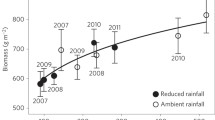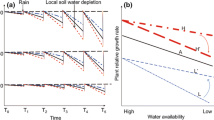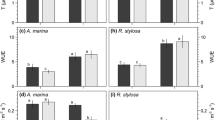Abstract
In order to understand plant responses to both the widespread phenomenon of increased nutrient inputs to coastal zones and the concurrent rise in atmospheric CO2 concentrations, CO2–nutrient interactions need to be considered. In addition to its potential stimulating effect on photosynthesis and growth, elevated CO2 affects the temperature response of photosynthesis. The scarcity of experiments testing how elevated CO2 affects the temperature response of tropical trees hinders our ability to model future primary productivity. In a glasshouse study, we examined the effects of elevated CO2 (800 ppm) and nutrient availability on seedlings of the widespread mangrove Avicennia germinans. We assessed photosynthetic performance, the temperature response of photosynthesis, seedling growth and biomass allocation. We found large synergistic gains in both growth (42 %) and photosynthesis (115 %) when seedlings grown under elevated CO2 were supplied with elevated nutrient concentrations relative to their ambient growing conditions. Growth was significantly enhanced under elevated CO2 only under high-nutrient conditions, mainly in above-ground tissues. Under low-nutrient conditions and elevated CO2, root volume was more than double that of seedlings grown under ambient CO2 levels. Elevated CO2 significantly increased the temperature optimum for photosynthesis by ca. 4 °C. Rising CO2 concentrations are likely to have a significant positive effect on the growth rate of A. germinans over the next century, especially in areas where nutrient availability is high.



Similar content being viewed by others
References
Ainsworth EA, Long SP (2005) What have we learned from 15 years of free-air CO2 enrichment (FACE)? A meta-analytic review of the responses of photosynthesis, canopy properties and plant production to rising CO2. New Phytol 165(2):351–372. doi:10.1111/j.1469-8137.2004.01224.x
Ainsworth EA, Rogers A, Blum H, Nösberger J, Long SP (2003) Variation in acclimation of photosynthesis in Trifolium repens after eight years of exposure to Free Air CO2 Enrichment (FACE). J Exp Bot 54(393):2769–2774. doi:10.1093/jxb/erg309
Alongi DM, Christoffersen P, Tirendi F (1993) The influence of forest type on microbial-nutrient relationships in tropical mangrove sediments. J Exp Mar Biol Ecol 171(2):201–223. doi:10.1016/0022-0981(93)90004-8
Andrews TJ, Muller GJ (1985) Photosynthetic gas exchange of the mangrove, Rhizophora stylosa Griff., in its natural environment. Oecologia 65(3):449–455. doi:10.1007/BF00378922
Balke T, Bouma T, Horstman E, Webb E, Erftemeijer P, Herman P (2011) Windows of opportunity: thresholds to mangrove seedling establishment on tidal flats. Mar Ecol Prog Ser 440:1–9
Ball MC, Cowan IR, Farquhar GD (1988) Maintenance of leaf temperature and the optimisation of carbon gain in relation to water loss in a tropical mangrove forest. Aust J Plant Physiol 15:263–276
Ball MC, Cochrane MJ, Rawson HM (1997) Growth and water use of the mangroves Rhizophora apiculata and R. stylosa in response to salinity and humidity under ambient and eievated concentrations of atmospheric CO2. Plant Cell Environ 20:1158–1166
Battaglia M, Beadle C, Loghhead S (1996) Photosynthetic temperature responses of Eucalyptus globulus and Eucalyptus nitens. Tree Physiol 16:81–89
Beaumont LJ, Pitman A, Perkins S, Zimmermann NE, Yoccoz NG, Thuiller W (2011) Impacts of climate change on the world’s most exceptional ecoregions. Proc Natl Acad Sci 108(6):2306–2311. doi:10.1073/pnas.1007217108
Bernacchi CJ, Singsaas EL, Pimentel C, Portis AR Jr, Long SP (2001) Improved temperature response functions for models of Rubisco-limited photosynthesis. Plant Cell Environ 24(2):253–259. doi:10.1111/j.1365-3040.2001.00668.x
Berry J, Björkman O (1980) Photosynthetic response and adaptation to temperature in higher plants. Annu Rev Plant Physiol 31(1):491–543. doi:10.1146/annurev.pp.31.060180.002423
Björkman O, Demmig B, Andrews T (1988) Mangrove photosynthesis: response to high-irradiance stress. Funct Plant Biol 15(2):43–61. doi:10.1071/PP9880043
Cernusak LA, Winter K, Martínez C, Correa E, Aranda J, Garcia M, Jaramillo C, Turner BL (2011a) Responses of legume versus nonlegume tropical tree seedlings to elevated CO2 concentration. Plant Physiol 157(1):372–385. doi:10.1104/pp.111.182436
Cernusak LA, Winter K, Turner BL (2011b) Transpiration modulates phosphorus acquisition in tropical tree seedlings. Tree Physiol 31(8):878–885. doi:10.1093/treephys/tpr077
Cernusak LA, Winter K, Dalling JW, Holtum JAM, Jaramillo C, Körner C, Leakey ADB, Norby RJ, Poulter B, Turner BL, Wright SJ (2013) Tropical forest responses to increasing atmospheric CO2: current knowledge and opportunities for future research. Funct Plant Biol 40:531–551
Chapin FS (1980) The mineral nutrition of wild plants. Annu Rev Ecol Syst 11:233–260
Cheeseman JM, Clough BF, Carter DR, Lovelock CE, Eong O, Sim RG (1991) The analysis of photosynthetic performance in leaves under field conditions: a case study using Bruguiera mangroves. Photosynth Res 29(1):11–22. doi:10.1007/BF00035202
Chen R, Twilley R (1999) Patterns of mangrove forest structure and soil nutrient dynamics along the Shark River estuary, Florida. Estuaries 22(4):955–970. doi:10.2307/1353075
Dillaway DN, Kruger EL (2010) Thermal acclimation of photosynthesis: a comparison of boreal and temperate tree species along a latitudinal transect. Plant Cell Environ 33(6):888–899. doi:10.1111/j.1365-3040.2010.02114.x
Drake BG, Gonzàlez-Meler MA, Long SP (1997) More efficient plants: a consequence of rising atmospheric CO2? Annu Rev Plant Physiol Plant Mol Biol 48(1):609–639. doi:10.1146/annurev.arplant.48.1.609
Duarte CM, Losada IJ, Hendriks IE, Mazarrasa I, Marba N (2013) The role of coastal plant communities for climate change mitigation and adaptation. Nat Clim Change 3(11):961–968. doi:10.1038/nclimate1970
Duke NC, Ball MC, Ellison JC (1998) Factors influencing biodiversity and distributional gradients in mangroves. Glob Ecol Biogeogr Lett 7(1):27–47. doi:10.2307/2997695
Dybzinski R, Farrior CE, Pacala SW (2015) Increased forest carbon storage with increased atmospheric CO2 despite nitrogen limitation: a game-theoretic allocation model for trees in competition for nitrogen and light. Glob Change Biol 21(3):1182–1196. doi:10.1111/gcb.12783
Eveland AL, Jackson DP (2012) Sugars, signalling, and plant development. J Exp Bot 63(9):3367–3377. doi:10.1093/jxb/err379
Farnsworth EJ, Ellison AM, Gong WK (1996) Elevated CO2 alters anatomy, physiology, growth, and reproduction of red mangrove (Rhizophora mangle L.). Oecologia 108(4):599–609. doi:10.1007/bf00329032
Farquhar GD, von Caemmerer S, Berry JA (1980) A biochemical model of photosynthetic CO2 assimilation in leaves of C3 species. Planta 149(1):78–90. doi:10.1007/BF00386231
Feller IC, McKee KL, Whigham DF, O’Neill JP (2003) Nitrogen vs. phosphorus limitation across an ecotonal gradient in a mangrove forest. Biogeochemistry 62:145–175
Fromard F, Vega C, Proisy C (2004) Half a century of dynamic coastal change affecting mangrove shorelines of French Guiana. A case study based on remote sensing data analyses and field surveys. Mar Geol 208(2–4):265–280. doi:10.1016/j.margeo.2004.04.018
Griffin KL, Anderson OR, Gastrich MD, Lewis JD, Lin G, Schuster W, Seemann JR, Tissue DT, Turnbull MH, Whitehead D (2001) Plant growth in elevated CO2 alters mitochondrial number and chloroplast fine structure. Proc Natl Acad Sci 98(5):2473–2478. doi:10.1073/pnas.041620898
Hättenschwiler S, Körner C (1997) Biomass allocation and canopy development in spruce model ecosystems under elevated CO2 and increased N deposition. Oecologia 113(1):104–114. doi:10.1007/s004420050358
Hutchison J, Manica A, Swetnam R, Balmford A, Spalding M (2014) Predicting global patterns in mangrove forest biomass. Conserv Lett 7(3):233–240. doi:10.1111/conl.12060
IPCC (2013) Climate change 2013: The physical science basis. Contribution of working group I to the fifth assessment report of the intergovernmental panel on climate change. Cambridge University Press, Cambridge, New York. doi:10.1017/CBO9781107415324
Jordan D, Ogren W (1984) The CO2/O2 specificity of ribulose 1,5-bisphosphate carboxylase/oxygenase. Planta 161(4):308–313. doi:10.1007/BF00398720
Kirschbaum MUF (2011) Does enhanced photosynthesis enhance growth? Lessons learned from CO2 enrichment studies. Plant Physiol 155(1):117–124. doi:10.1104/pp.110.166819
Koch MS, Coronado C, Miller MW, Rudnick DT, Stabenau E, Halley RB, Sklar FH (2015) Climate change projected effects on coastal foundation communities of the Greater Everglades using a 2060 scenario: need for a new management paradigm. Environ Manag 55(4):857–875. doi:10.1007/s00267-014-0375-y
Körner C (2006) Plant CO2 responses: an issue of definition, time and resource supply. New Phytol 172(3):393–411. doi:10.1111/j.1469-8137.2006.01886.x
Krause GH, Winter K, Krause B, Jahns P, García M, Aranda J, Virgo A (2010) High-temperature tolerance of a tropical tree, Ficus insipida: methodological reassessment and climate change considerations. Funct Plant Biol 37(9):890–900. doi:10.1071/FP10034
Krause GH, Winter K, Krause B, Virgo A (2014) Light-stimulated heat tolerance in leaves of two neotropical tree species, Ficus insipida and Calophyllum longifolium. Funct Plant Biol 42(1):42–51. doi:10.1071/FP14095
Krauss KW, McKee KL, Lovelock CE, Cahoon DR, Saintilan N, Reef R, Chen L (2014) How mangrove forests adjust to rising sea level. New Phytol 202(1):19–34. doi:10.1111/nph.12605
Leakey ADB, Xu F, Gillespie KM, McGrath JM, Ainsworth EA, Ort DR (2009) Genomic basis for stimulated respiration by plants growing under elevated carbon dioxide. Proc Natl Acad Sci 106(9):3597–3602. doi:10.1073/pnas.0810955106
Lloyd J, Farquhar GD (2008) Effects of rising temperatures and [CO2] on the physiology of tropical forest trees. Philos Trans R Soc Lond B Biol Sci. doi:10.1098/rstb.2007.0032
Long SP (1991) Modification of the response of photosynthetic productivity to rising temperature by atmospheric CO2 concentrations: has its importance been underestimated? Plant Cell Environ 14(8):729–739. doi:10.1111/j.1365-3040.1991.tb01439.x
Luo Y, Su B, Currie WS, Dukes JS, Finzi A, Hartwig U, Hungate B, McMurtrie RE, Oren R, Parton WJ, Pataki DE, Shaw RM, Zak DR, Field CB (2004) Progressive nitrogen limitation of ecosystem responses to rising atmospheric carbon dioxide. Bioscience 54(8):731–739
McKee KL, Rooth JE (2008) Where temperate meets tropical: multi-factorial effects of elevated CO2, nitrogen enrichment, and competition on a mangrove-salt marsh community. Glob Change Biol 14(5):971–984. doi:10.1111/j.1365-2486.2008.01547.x
Miller PC (1972) Bioclimate, leaf temperature, and primary production in red mangrove canopies in South Florida. Ecology 53(1):22–45. doi:10.2307/1935708
Norby RJ, Warren JM, Iversen CM, Medlyn BE, McMurtrie RE (2010) CO2 enhancement of forest productivity constrained by limited nitrogen availability. Proc Natl Acad Sci 107(45):19368–19373. doi:10.1073/pnas.1006463107
Nowak RS, Ellsworth DS, Smith SD (2004) Functional responses of plants to elevated atmospheric CO2—do photosynthetic and productivity data from FACE experiments support early predictions? New Phytol 162(2):253–280. doi:10.1111/j.1469-8137.2004.01033.x
Oren R, Ellsworth DS, Johnsen KH, Phillips N, Ewers BE, Maier C, Schafer KVR, McCarthy H, Hendrey G, McNulty SG, Katul GG (2001) Soil fertility limits carbon sequestration by forest ecosystems in a CO2-enriched atmosphere. Nature 411:469–472
Osland MJ, Enwright N, Day RH, Doyle TW (2013) Winter climate change and coastal wetland foundation species: salt marshes vs. mangrove forests in the southeastern United States. Glob Change Biol 19(5):1482–1494. doi:10.1111/gcb.12126
Phillips RP, Finzi AC, Bernhardt ES (2011) Enhanced root exudation induces microbial feedbacks to N cycling in a pine forest under long-term CO2 fumigation. Ecol Lett 14(2):187–194. doi:10.1111/j.1461-0248.2010.01570.x
Pierret A, Gonkhamdee S, Jourdan C, Maeght J-L (2013) IJ_Rhizo: an open-source software to measure scanned images of root samples. Plant Soil 373(1–2):531–539. doi:10.1007/s11104-013-1795-9
Poorter H, Niklas KJ, Reich PB, Oleksyn J, Poot P, Mommer L (2012) Biomass allocation to leaves, stems and roots: meta-analyses of interspecific variation and environmental control. New Phytol 193(1):30–50. doi:10.1111/j.1469-8137.2011.03952.x
Quisthoudt K, Adams J, Rajkaran A, Dahdouh-Guebas F, Koedam N, Randin C (2013) Disentangling the effects of global climate and regional land-use change on the current and future distribution of mangroves in South Africa. Biodivers Conserv 22(6–7):1369–1390. doi:10.1007/s10531-013-0478-4
Reef R, Lovelock CE (2014a) Historical analysis of mangrove leaf traits throughout the 19th and 20th centuries reveals differential responses to increases in atmospheric CO2. Glob Ecol Biogeogr 23(11):1209–1214. doi:10.1111/geb.12211
Reef R, Lovelock CE (2014b) Regulation of water balance in mangroves. Ann Bot. doi:10.1093/aob/mcu174
Reef R, Ball MC, Feller IC, Lovelock CE (2010a) Relationships among RNA: DNA ratio, growth and elemental stoichiometry in mangrove trees. Funct Ecol 24(5):1064–1072
Reef R, Feller IC, Lovelock CE (2010b) Nutrition of mangroves. Tree Physiol 30(9):1148–1160. doi:10.1093/treephys/tpq048
Reef R, Schmitz N, Rogers BA, Ball MC, Lovelock CE (2012) Differential responses of the mangrove Avicennia marina to salinity and abscisic acid. Funct Plant Biol 39(12):1038–1046. doi:10.1071/FP12178
Reef R, Winter K, Morales J, Adame MF, Reef DL, Lovelock CE (2015) The effect of atmospheric carbon dioxide concentrations on the performance of the mangrove Avicennia germinans over a range of salinities. Physiol Plant 154(3):358–368. doi:10.1111/ppl.12289
Reich PB, Hobbie SE, Lee T, Ellsworth DS, West JB, Tilman D, Knops JMH, Naeem S, Trost J (2006) Nitrogen limitation constrains sustainability of ecosystem response to CO2. Nature 440(7086):922–925. http://www.nature.com/nature/journal/v440/n7086/suppinfo/nature04486_S1.html
Saintilan N, Wilson NC, Rogers K, Rajkaran A, Krauss KW (2014) Mangrove expansion and salt marsh decline at mangrove poleward limits. Glob Change Biol 20(1):147–157. doi:10.1111/gcb.12341
Slot M, Winter K (2016) The effects of rising temperature on the ecophysiology of tropical forest trees. In: Goldstein G, Santiago LS (eds) Tropical tree physiology—adaptations and responses in a changing environment. Springer, Switzerland, p 467
Smith JAC, Popp M, Luttge U, Cram WJ, Diaz M, Griffiths H, Lee HSJ, Medina E, Schafer C, Stimmel KH, Thonke B (1989) Ecophysiology of xerophytic and halophytic vegetation of a coastal alluvial plain in northern Venezuela. VI. Water relations and gas exchange of mangroves. New Phytol 111(2):293–307. doi:10.2307/2556867
Taub DR, Seemann JR, Coleman JS (2000) Growth in elevated CO2 protects photosynthesis against high-temperature damage. Plant Cell Environ 23:649–656
Team RDC (2014) R: a language and environment for statistical computing. R Foundation for Statistical Computing, Vienna
van der Sleen P, Groenendijk P, Vlam M, Anten NPR, Boom A, Bongers F, Pons TL, Terburg G, Zuidema PA (2015) No growth stimulation of tropical trees by 150 years of CO2 fertilization but water-use efficiency increased. Nat Geosci 8(1):24–28. doi:10.1038/ngeo2313
Winter K, Aranda J, Garcia M, Virgio A, Paton S (2001a) Effect of elevated CO2 and soil fertilization on whole-plant growth and water use in seedlings of a tropical pioneer tree, Ficus insipida. Flora Morphol Geobot Ecophysiol 196(6):458–464
Winter K, Garcia M, Gottsberger R, Popp M (2001b) Marked growth response of communities of two tropical tree species to elevated CO2 when soil nutrient limitation is removed. Flora 196(1):47–58
Woodroffe CD, Grindrod J (1991) Mangrove biogeography: the role of quaternary environmental and sea-level change. J Biogeogr 18(5):479–492. doi:10.2307/2845685
Yamori W, Hikosaka K, Way DA (2013) Temperature response of photosynthesis in C3, C4, and CAM plants: temperature acclimation and temperature adaptation. Photosynth Res 119(1):101–117. doi:10.1007/s11120-013-9874-6
Acknowledgements
We would like to thank Dr Aurelio Virgo for technical support. Funding for this study was provided by an Australian Research Council Discovery Early Career Research Award to RR (DE120101706) and a Marie Curie Fellowship to RR (FP7-623720—STORM). Propagules were collected under Autoridad Nacional del Ambiente, Panama scientific permit No. SC/P-7-14. All data used in this manuscript are presented in the manuscript.
Author information
Authors and Affiliations
Corresponding author
Rights and permissions
About this article
Cite this article
Reef, R., Slot, M., Motro, U. et al. The effects of CO2 and nutrient fertilisation on the growth and temperature response of the mangrove Avicennia germinans . Photosynth Res 129, 159–170 (2016). https://doi.org/10.1007/s11120-016-0278-2
Received:
Accepted:
Published:
Issue Date:
DOI: https://doi.org/10.1007/s11120-016-0278-2




